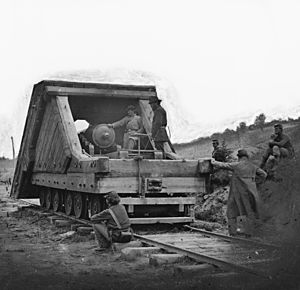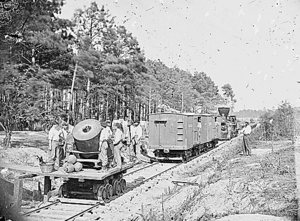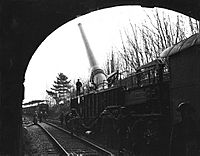Railway gun facts for kids
A railway gun is a very large artillery weapon. It was built on, moved by, and fired from a special railway wagon. Many countries made these guns, but the most famous ones were built by Krupp and used by Germany in World War I and World War II. Smaller guns were sometimes part of an armoured train.
Railway guns are not used anymore. They were very big and could only move where train tracks went. This made them easy targets for enemies. Today, aircraft, rockets, and missiles have taken their place.
Contents
How Railway Guns Started
The idea for railway guns came about in the 1860s. A man named Mr. Anderson in the United Kingdom wrote a paper called National Defence. He suggested using strong, iron-covered railway carriages for defense. Around the same time, a Russian named Lebedew claimed he put a mortar (a type of cannon) on a railway car in 1860.
The first railway gun used in a real battle was a 32-pounder Brooke naval rifle. This happened during the American Civil War. It was placed on a flat train car and protected with iron sheets. On June 29, 1862, Robert E. Lee used this gun at the Battle of Savage's Station.
Another famous railway gun from that war was a 13-inch siege mortar. It was mounted on a rail car during the Siege of Petersburg, Virginia. People called it the Dictator or the Petersburg Express.
Railway guns were also used by France during the Siege of Paris in 1870. The British used them during the Second Boer War at the Siege of Ladysmith.
Railway Guns in World War I
When World War I began, France did not have enough heavy guns for fighting on land. So, they moved large coastal defense guns and naval guns to the front lines. These guns were usually too big for regular use. Putting them on railway cars was a good solution. By 1916, both sides in the war were using railway guns.
Baldwin Locomotive Works, a company in the United States, built five special 14"/50 caliber railway guns for the United States Navy. This happened in 1918. Each train carried a Mk 4 14"/50 caliber gun. This was a 14 in (360 mm) naval gun, usually found on large battleships. It was placed on a rail carriage with four sets of six wheels. One of these guns is still on display today outside the National Museum of the United States Navy at the Washington Navy Yard.
Railway Guns in World War II
The Second World War was the last time railway guns were used in battle. The Germans used a huge gun called the 80 cm (31 in) Schwerer Gustav. This was the largest artillery piece ever used in a fight.
However, the rise of the airplane changed warfare forever. Airplanes could easily spot and attack these large, slow-moving railway guns. Like battleships, railway guns were big, expensive, and easy to destroy from the air. This made them less useful, and they were eventually replaced by other weapons.
Where to See Surviving Railway Guns
You can still see some of these impressive railway guns today:
- A 12 inch railway gun is at the Naval Surface Warfare Center Dahlgren Division in Dahlgren, Virginia.
- A US Navy 14"/50 caliber railway gun from World War I is at the Washington Navy Yard, DC.
- A German Krupp K5 gun, nicknamed "Anzio Annie", is on display at the United States Army Ordnance Training and Heritage Center. It was made from parts of two German guns that attacked the Anzio beachhead.
- Another K5 gun can be seen at the Battery Todt museum, near Audinghen in northern France.
- Soviet-era 305mm MK-3-12 guns are on show at the Krasnaya Gorka fort near Lomonosov, Russia, and the Museum of Railway Technology in Saint Petersburg.
- Soviet ТМ-1-180 180mm guns can be seen at Krasnaya Gorka fort, the Museum of the Great Patriotic War, Moscow, and at Sevastopol Railway Station in Ukraine.
- The last remaining American-made Bethlehem 177 coastal railway gun is on display at Museu Militar Conde de Linhares in Rio de Janeiro, Brazil.
Images for kids
See also
 In Spanish: Cañón ferroviario para niños
In Spanish: Cañón ferroviario para niños












